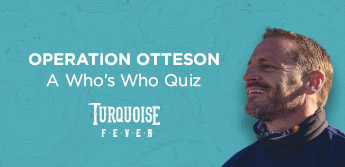
Show Your State Food Some Love!
Unearthing high-grade turquoise from the ground is not an easy task. After the precise locating of the turquoise veins and the dangerous blasting to get to the precious stone, the process is far from over. Below is a comprehensive list of exactly how the Otteson clan from INSP’s original series, Turquoise Fever creates their final cabochons.

Once the turquoise is excavated, it’s collected and brought back to the shop. That’s where the process begins to turn the rough turquoise into the shiny, polished stones that we all know and love.

A diamond saw blade is used to saw waste rock from the rough stone, shaping the turquoise into a flat quarter inch slab.
An epoxy mixture is poured onto wax paper until it is as thick as a dime. The Ottesons keep the backing as thin as possible to ensure the value of the stone stays intact.
The prepped turquoise slabs are then set against the backing before it hardens. It takes at least 24 hours for the backing to harden and the stones are ready for the next step.
The sheet of epoxy with the stone slabs glued onto it is peeled off from the wax paper, and taken back to the diamond saw blade to separate the stones from one another.
Once the stones are separated, The Ottesons use a thinner blade to trim off any excess backing.

Stones are pre-formed with the use of a thicker, more rigid saw blade. Pre-forming saves time by giving the stone its basic rough shape with a flat back.
To clean the backing, the stones are placed upside down and washed by hand. Afterward, they are laid out in the sun to dry.
For easier handling during the rest of the process, dopping sticks are attached to hold the turquoise cabochons while they take shape. The Ottesons apply hot glue to the epoxy backing, dipping the dopping stick into the glue before it hardens. Once it sets, it is ready for the cutting process.
At the first step of the cutting process, the Ottesons use a 100 grit cutting wheel to create a bezel and dome-shaped top. The cutting wheel doesn’t cut the stone but instead grinds it. Water is used to prevent the stone from cracking.
Now that the stone is in its desired shape, a 200 grit wheel is used to begin grinding out any scratches.
The Ottesons move onto a 400 grit cutting wheel. At this point, the cabochons are being sanded, rather than ground.
An 800 grit wheel is used to remove any scratches. The higher the grit of the cutting wheel, the smoother the stone gets.

The Ottesons then use a 1,200 grit cutting wheel. Now, the stone is beginning to look polished.
A 3,000 grit cutting wheel, the last wheel used in the cutting process, smooths out any imperfections that are left.
The stones are washed, scrubbed, and then left out in the sun to dry. Leaving them in the sun removes any water from the surface to reveal any hidden scratches.
Each stone goes through an inspection to check for flaws. The ones with flaws go back to the cutting wheel for another round. The stones that pass inspection move on to the next step.
The stones are polished with a damp leather pad that attaches to the cutting wheel. Aluminum oxide powder is then mixed with water to create a paste. The stones are dipped in the paste and pressed against the high-speed leather wheel up to eight times.
The turquoise cabochons get another wash to remove the aluminum oxide paste.
The stones head to the buffing wheel. The buffing wheel has a spinning motor with a cloth wheel. A waxy bar called zam, a binding agent containing up to 30,000 grit polishing powder is spun against the buffing wheel. Then the stones are run through the wheel up to four times for its final high polish look.
The stones get one last wash and are scrubbed with a toothbrush to remove any debris.
To soften the glue that holds the dopping sticks in place, the Ottesons submerge the cabochons into a can of hot water. They then use a knife to pop the sticks off the stones and remove any excess glue.

The stones are ready for their last inspection. The ones that pass are then set into jewelry or sold to the Otteson’s clients.
In their task of mining turquoise, the Otteson family is extremely sensitive to conservation issue and passionate about protecting the environment. Throughout the history of the family they have shown respect for the land. Central to every project is “reclamation,” going to the spot that has been dug, and restoring the land to its natural setting. This very extensive process involves replacing brush, trees, and anything else needing to be replaced. Their goal: When they are finished, no one would be able to tell they were there.
The Ottesons also work hand-in-hand with the national and state environmental protection agencies for every project. In fact, the hope is that a future episode of Turquoise Fever will include their conservation efforts.
| Strike Out or Strike it Rich | Operation Otteson |
 |
 |